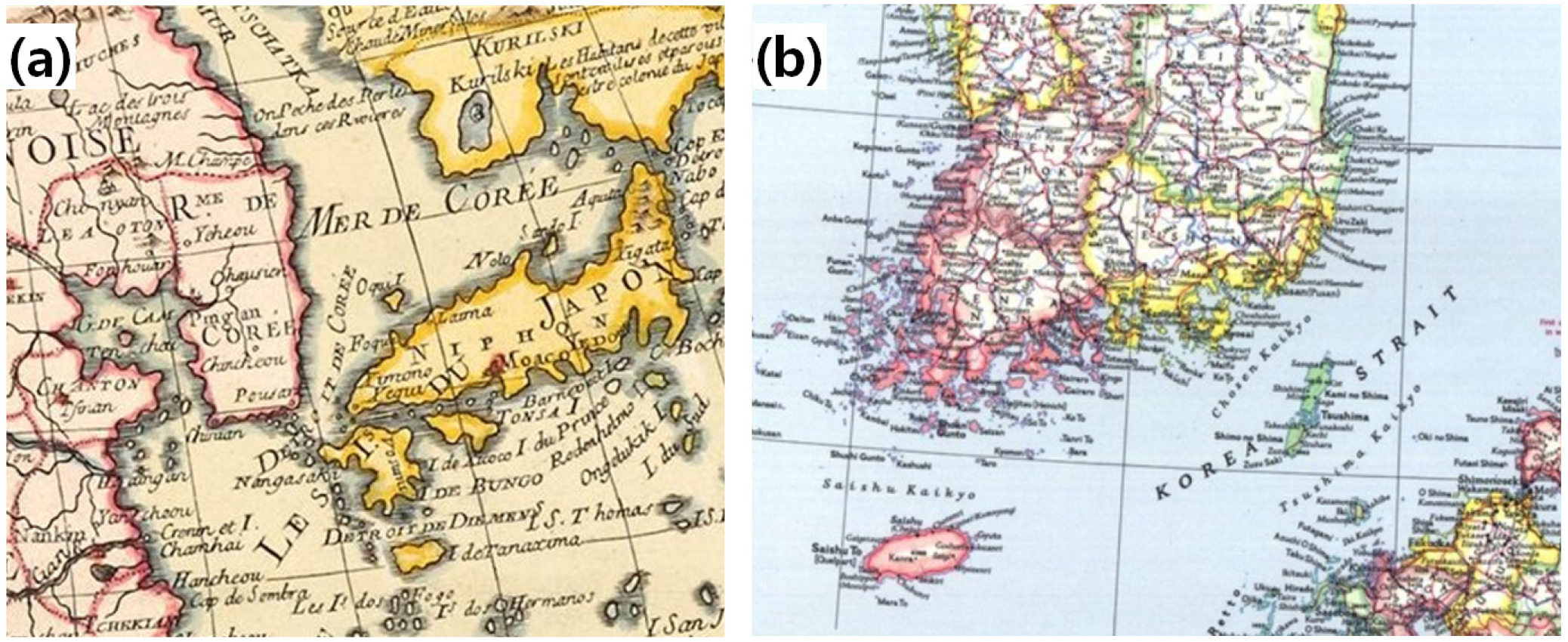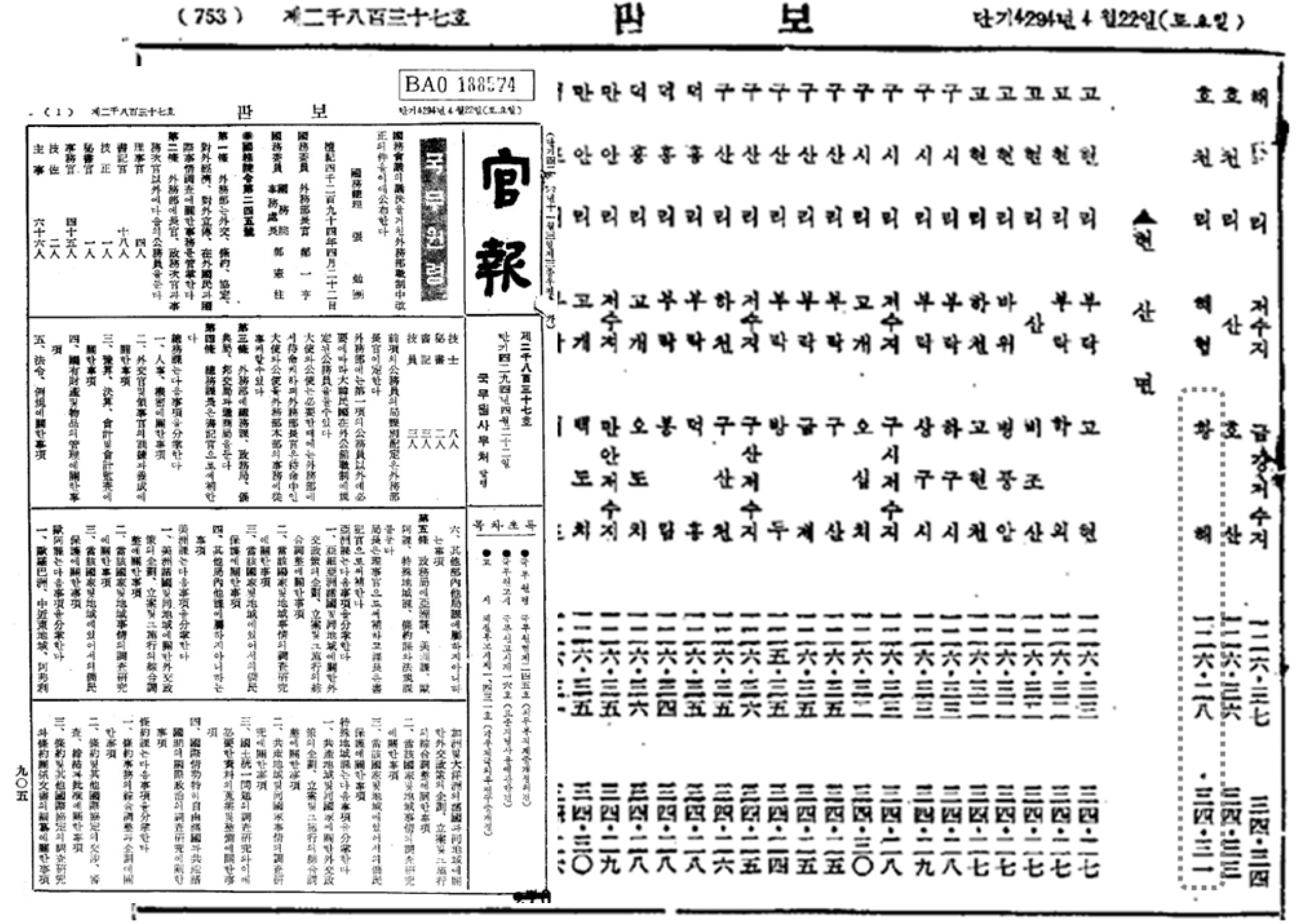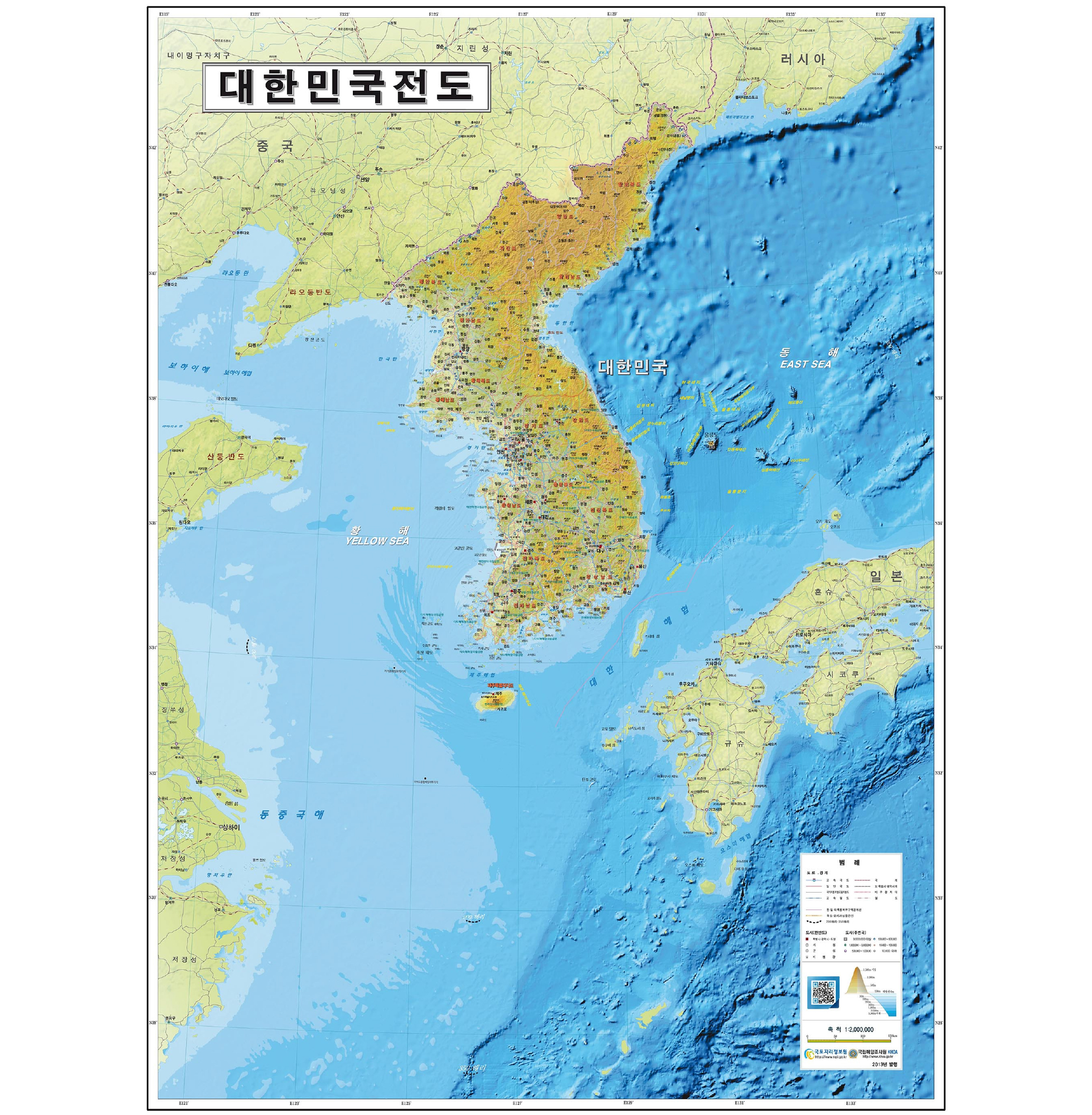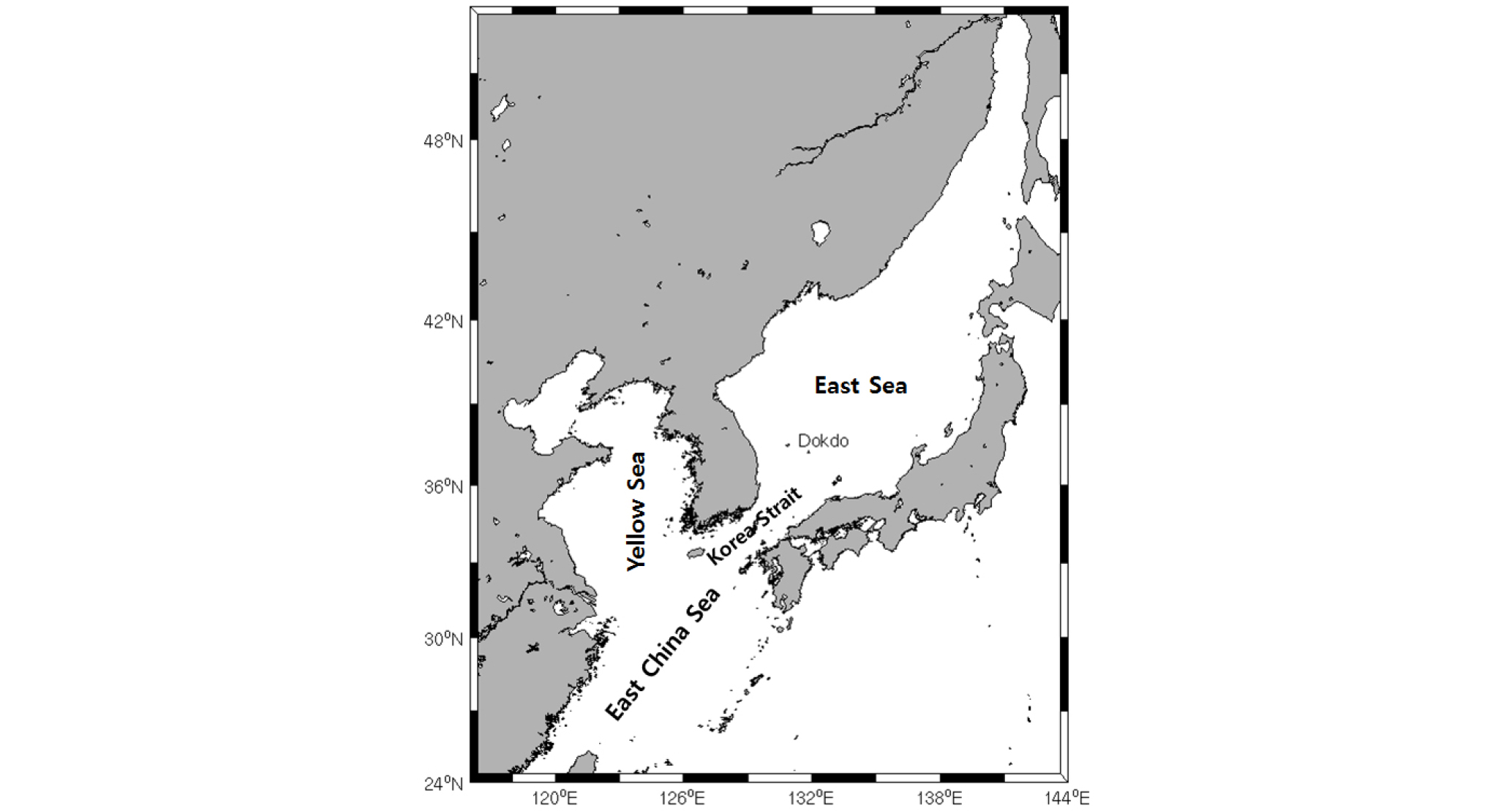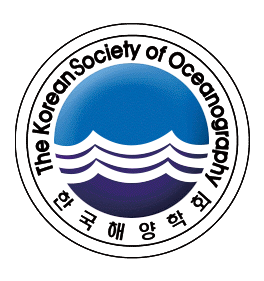1. 서 론
보통 해양 연구자들은 자연과학 논문을 작성할 때 연구 대상 해역 등을 알기 쉽게 표기하기 위하여 지도를 사용하며, 이때 그림에는 바다 이름을 영문으로 표기한다. 주변해 또는 우리나라 연안해역1)과 관할해역2)의 바다를 조사·연구하여 논문을 작성해 본 경험이 있는 연구자들이라면 바다 이름을 지도에 표기할 때 영문표기 방법을 한번쯤 고민해 본 경험들을 가지고 있을 것이다. 그 주된 이유 중 하나는 주변해와 우리나라 연안해역에 대한 바다 이름 표기에 관한 기준뿐만 아니라 관련 전문 교육 교재 등이 거의 없기 때문이다. 또한 ‘동해’ 바다 이름을 두고 일본과 대립하고 있는 상황에서 그간 우리정부는 관련 학회와 유관기관들과의 협력을 통하여 우선적으로 ‘동해(East Sea)’ 표기에 대해 국제사회의 이해를 제고시키고, 이 이름을 확산시키는데 주력해 왔다.
1) 연안관리법(제2조제1항)에 따르면 “연안”이란 연안해역과 연안육역을 말한다. 이 중 연안해역은 바닷가와 바다 지역을 말하며(제2조제2항), 이 바다는 「공간정보의 구축 및 관리 등에 관한 법률」 제6조제1항제4호(즉, 해안선은 해수면이 약최고고조면에 이르렀을 때의 육지와 해수면과의 경계로 표시한다.)에 따른 해안선으로부터 영해(嶺海)의 외측한계(外側限界)까지의 사이를 말한다.
2) 관할해역이란 다음 각 목의 어느 하나에 해당하는 해역을 말한다(해양과학조사법 제2조제4항). 가. 「영해 및 접속수역법」에 따른 내수(內水) 및 영해, 나. 「배타적 경제수역법」에 따른 배타적 경제수역(經濟水域), 다. 대한민국이 주권적 권리 및 관할권을 행사하는 대륙붕.
바다는 해저지형이 해수로 채워져 있는 연속된 공간으로서 우리나라 주변 바다는 인접국과 공유하고 있는 바다임에도 불구하고, 우리나라의 삼면은 바다와 접해 있기 때문에 국내 연구자들은 우리나라를 중심으로 서쪽에 있는 연안해역을 ‘서해’로, 남쪽에 있는 연안해역을 ‘남해’로 표기하는 데 더 친숙하다. 현재까지 국제사회에서 이들 바다 이름들은 공식적으로 통용되지 않는다(Fig. 1과 Fig. 2). ‘동해’의 남쪽 경계가 국제적으로는 우리가 이른바 ‘남해’라 부르는 해역을 포함하고 있다는 사실을 정확하게 알고 사용하는 연구자들은 많지 않다. 이 해역은 국제항로로서 적어도 1732년부터 국제적으로 ‘대한해협(Korea Strait)’으로 불려 왔다(Park et al., 2015). 우리나라와 중국 사이에 위치한 평균 수심 44 m의 얕은 바다의 이름은 ‘황해(Yellow Sea)’이다. 국내 많은 해양연구들이 황해 전체가 아닌 주로 우리나라 관할해역 내 연안해역에서 집중적으로 이루어지고 있다는 점에서 연구자들 사이에 ‘서해’라는 이름이 관행·관용적으로 많이 사용되고 있다. 국내 논문의 경우에 ‘황해’ 대신에 ‘서해’라는 바다 이름을 사용하면 부가적으로 방위를 나타내는 수식어(예를 들어, 황해 동쪽 해역)를 사용할 필요가 없어서 편리할 뿐만 아니라 논문을 읽는 독자들이 대상해역의 위치를 쉽게 파악할 수 있다는 이점이 있다.
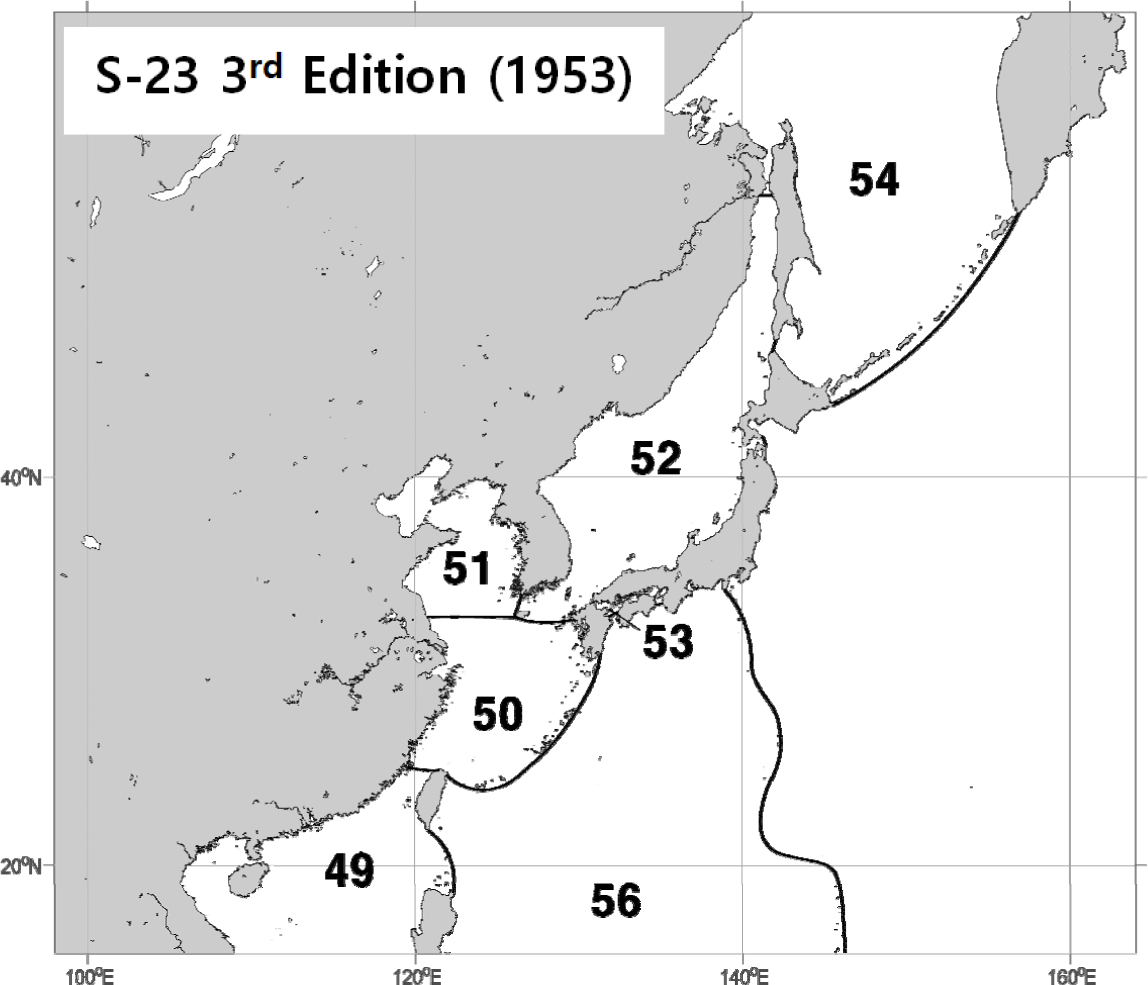
Fig. 1.
Names and limits of seas around Korea redrawn from S-23 3rd edition (‘Limits of Oceans and Seas’) published by the International Hydrographic Bureau (IHB) in 1953: numbers indicate the Yellow Sea (51); Eastern China Sea (50); Japan Sea (52); Seto Naikai or Inland Sea (53); Philippine Sea (56); Sea of Okhotsk (54); and South China Sea (49).
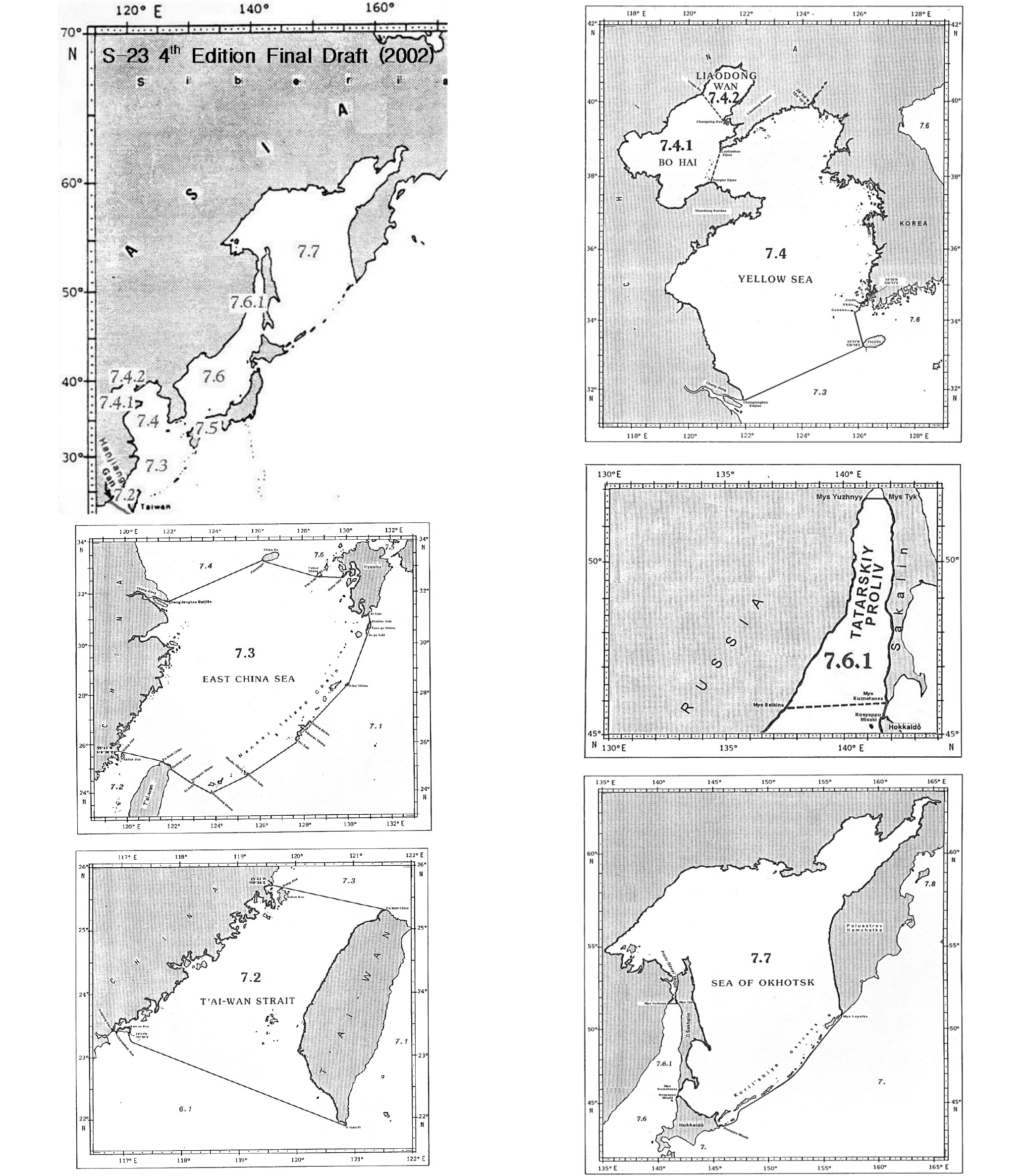
Fig. 2.
Names and limits of seas around Korea contained in S-23 4th edition final draft (‘Names and Limits of Oceans and Seas’) drawn up by IHB in 2002: numbers indicate the Yellow Sea (7.4); Taiwan Strait (7.2); East China Sea (7.3); Seto Naikai (7.5); Tararskiy Proliv [Strait] (7.6.1) and Sea of Okhotsk (7.7). Note that the area occupied by the East Sea (7.6) is not named.
Seo and Kim (2014)에 따르면 ‘동해’는 삼국사기와 삼국유사 기록에서 알 수 있듯이 2천년 이상 우리민족이 사용한 토착지명(endonym)3)으로서 ‘북해(North Sea)’처럼 ‘동쪽에 있는 바다’라는 어원적 의미가 오래 전에 사라진 고유명사이다. 따라서 국내 연구자들 사이에 ‘동해’ 바다 명칭 사용은 매우 자연스러운 일이다. 나아가 동해가 토착지명으로 17세기 후반에 프랑스에 알려진 후 그 나라 지도제작자인 기욤 드릴(Guillaume Delisle)에 의해 처음으로 ‘東海(동해)’의 역어인 유라시아(Eurasia)의 동쪽에 있는 바다 즉, ‘Mer Orientale(동해)’가 사용되었다.
3) 1965년 7월 15일에 설립된 유엔지명표준화회의(The United Nations Conferences on the Standardization of Geographical Names, UNCSGN)는 바다의 명칭을 포함하여 일반적인 지리 명칭의 표준화 문제를 다루는 유엔 산하의 국제기구로, 이 기구는 당사국간 협의가 불가능할 경우 바다 명칭 병기를 권하고 있으며, 또 외래지명(exonym)보다 토착지명(endonym)을 우선으로 하도록 1977년에 결의(결의안 III/20)하였다. 나아가 바다 명칭을 전문으로 다루는 국제수로기구(International Hydrographic Organization, IHO)가 1972년에 두 개 이상의 국가가 공유하고 있는 지형물에 대하여 각각 다른 지명이 사용될 경우 단일 명칭에 합의하도록 노력할 것을 권고(기술결의안 A4.2.6) 하였음에도 불구하고 일본정부는 지금까지 타협을 거부하고 있다.
그 동안 학술지를 대상으로 한 바다 표기에 관한 연구는 ‘동해’ 명칭 표기의 국제적 확산의 일환으로 국제 학술지를 대상으로 한 ‘동해’ 표기에 관한 분석이 집중적으로 이루어져 왔다. 예를 들어, Kang et al. (2009)은 각 학회지별로 인터넷 검색이 가능한 시점부터 2006년까지 출간된 24종의 해양학 분야 국제학술지 472편의 논문을 분석하여 ‘동해’ 표기현황을 조사하였다. 나아가 Han (2015)은 Web of Science 데이터베이스(database)를 이용하여 4,192편의 국제학술지에 나타난 ‘동해’ 표기 유형별 특성을 계량적으로 분석하였다. 이처럼 이들 연구는 국제 학술지를 대상으로 ‘동해’ 표기 분석에 집중되었다. 그 동안 국내 해양 또는 수산 관련 학술지를 대상으로 동해뿐만 아니라 우리나라 주변 바다와 연안 바다 이름표기에 대한 분석은 없었다. 국내 학회지에 실린 논문이더라도 일반적으로 지도(map)에는 영어로 바다 이름을 표기하므로 이 점에서 대표적인 국내 학회지에 실린 지도를 분석하면 국내 연구자들의 우리나라 주변 바다와 관할해역 바다 이름표기에 대한 경향을 파악할 수 있다.
이 연구에서는 국내 주요 해양 ·수산 전문학회지인 한국해양학회지 ‘바다(The Sea)’와 한국수산과학회지 ‘The Korean Journal of Fisheries and Aquatic Science (KFAS)’에 출간된 한글 논문들을 분석하여 연구자들마다 달리 사용하고 있는 주변해와 우리나라 연안해역의 바다 명칭 사용에 관한 현황을 살펴보고 그 해결 방안을 제시하고자 한다. 이를 위해 지난 20년(1998-2017년)간 ‘바다(The Sea)’와 ‘KFAS’에 실린 한글 논문들 중 지도에 우리나라 주변 바다 이름을 표기한 논문들을 대상으로 바다 이름표기 현황을 분석하였다. 이 결과를 바탕으로 이들 연구논문에서 사용된 바다 이름표기 특성을 살펴보았다. 끝으로 주변해와 우리나라 연안해역을 대상으로 한 논문 작성 시 바다 이름표기에 관한 기준을 제안하고자 한다.
2. 국제적으로 통용되는 우리나라 주변 바다 명칭 현황
국제수로기구(International Hydrographic Organization: IHO)4)는 항해 안전과 해양환경 보전을 지원하기 위해 1921년에 설립된 국가 간 자문 기술 기구로서 전 세계 해양과 바다 명칭을 관장하고 있다. IHO (즉, 그 당시 IHB)는 1928년에 처음으로 전 세계 해양과 바다의 명칭과 구역을 정한 ‘해양과 바다의 경계(LIMITS OF OCEANS AND SEAS)’라는 책자(International Hydrographic Bureau, 1928)를 발간하였다. 일제강점기에 일본의 주장에 의해 동해가 일본해로 단독 표기된 이 특별간행물은 S-23 (Special Publication No. 23) 제1판으로 부르며, 1937년에 S-23 제2판(International Hydrographic Bureau, 1937)에 이어 1953년에 S-23 제3판(International Hydrographic Bureau, 1953)이 발행되었다. 이때까지 우리나라가 IHO (즉, IHB)에 미가입한 관계로 동해의 일본해 표기는 S-23 제3판에까지 그대로 유지되었다. 1986년에 S-23 제4판 ‘대양과 바다의 명칭과 경계(NAMES AND LIMITS OF OCEANS AND SEAS)’ 초안이 작성되었다(International Hydrographic Bureau, 1986). 이러한 과정 중에 1997년 제15차 국제수로 총회(International Hydrographic Conference)에서 우리정부는 1972년에 합의된 IHO 기술결의(A.4.2.6)에 근거하여 동해(East Sea)/일본해(Japan Sea) 병기표기를 주장하였다. 이로 인해 1986년 초안을 바탕으로 1998년부터 2002년까지 개정 추진된 S-23 제4판의 최종 초안(International Hydrographic Bureau, 2002)5)에는 동해의 바다 이름이 공란이다(Choo, 2012). 그러나 S-23 제4판의 발간을 승인받기 위해 2002년 8월에 IHO 회원국에 제출되었으나 일본이 병기표기를 반대하여 당시 국제수로사무국 이사회(IHB Directing Committee)에 의해 그해 9월 투표과정이 중단되었다. 따라서 전 세계의 지도 제작자들은 1953년에 개정된 S-23 제3판(Fig. 1)을 표준으로 해양과 바다의 명칭을 사용할 수밖에 없는 실정이다.
4) 국제수로국(International Hydrographic Bureau, IHB)은 1921년에 창설되었으며, 1970년 9월에 국제수로총회(International Hydrographic Conference), 이사회(Directing Committee), 국제수로사무국(IHB)으로 구성된 국제수로기구(International Hydrographic Organization, IHO)로 확대‧개편되었다. 국립해양조사원에서는 초기 IHB(국제수로기구)와 현재의 IHB(국제수로사무국)를 구분하기 위해 한글명을 달리 사용하고 있다.
5) S-23 제4판의 최종 초안에는 전 세계의 해양과 바다를 10개로 구역으로 나눈 후 각 장별로 이들 구역에 속한 해양과 바다에 대한 명칭과 그 경계에 대한 지리적 위치 정보를 담고 있다.
국내에서 통상 사용되는 ‘남해(South Sea)’는 S-23 제3판(Fig. 1) 또는 제4판 최종 초안(Fig. 2)에서 볼 수 있듯이 일본의 주장에 의해 ‘일본해’라 불리는 ‘동해(East Sea)’에 포함된 바다로 국제적으로 통용되는 바다 이름이 아니다. 이는 S-23 제1판(1928년)부터 제3판(1953년)이 발간될 때까지 우리나라가 일본강점기에 있거나 IHO에 가입할 수 없는 여건에 놓여 있어서, 일본의 일방적 주장에 의해 우리나라 주변 바다 명칭과 경계가 결정되었기 때문이다. 이 해역은 수평 공간상 우리나라 남해안과 일본 열도 4대 섬 중에서 남쪽 섬인 규슈(Kyushu) 사이의 바다로 동해와 동중국해를 연결하는 좁은 수로로 볼 수 있다(Kim, 2014). 이 바다는 국제항로로서 오래 전부터 국제적으로 대한해협(Korea Strait)이라 불렸다. 예컨대, Park et al. (2015)은 1732년 발간된 Gulliaume Danet의 아시아 전도(L’Asie Dressée sur de Nouveaux Mémoires Assujettis aux Observations)에서 최초로 대한해협이 프랑스어로 ‘Détroit de Corée’라고 지도에 표기된 것을 확인하였다(Fig. 3a). 심지어 일제강점기(1910.8.29.~1945.8.15.)가 끝난 해인 1945년 12월에 National Geographic Magazine에서 발간한 한국과 일본 지도(Japan and Korea map)에서도 이 해역이 ‘Korea Strait’로 표기된 것을 확인할 수 있다(Fig. 3b). 이처럼 대한해협은 오래 전부터 국제적으로 우리나라 남해안과 일본 규슈 사이의 바다로 통용되어 왔으며, 그 폭은 약 180 km이고, 길이는 약 280 km이며, 수심은 약 50~150 m인 것으로 알려져 있다. 대한해협 내 오른편 가운데에 대마도가 자리 잡고 있으며, 일본에선 한국과 대마도 사이를 서수도(西水道), 대마도와 규슈 사이를 동수도(東水道)라 부른다(Kim, 2014). 흥미롭게도 러일전쟁(1904. 02. 08.~1905. 09. 05.) 당시 일본 해군이 작성한 작전도 등에서 대한해협(남해)에 대하여 ‘고려해’ 또는 ‘조선해협’으로 표기한 사실에서 알 수 있듯이, 일본도 1905년까지는 대한해협을 일본이 주장하는 일본해에 포함되지 않은 독립된 바다로 인식했다(Park et al., 2015).
‘서해’의 공식적인 바다 이름은 ‘황해(Yellow Sea)’이다. ‘황해’의 바다 명칭은 1961년 4월 22일에 당시 국립지리원(현 국토지리정보원)의 중앙지명위원회에서 「표준지명사용에 관한 건」으로 고시(국무원고시 제16호)하였으며(Fig. 4), 1965년에 외무부, 문교부, 법무부 등 정부 관계관회의 이후 초‧중‧고교의 모든 교과서에 ‘황해’를 공식 지명으로 표기하였다. ‘황해’는 중국과도 접해 있는 바다로, 프랑스 지리학자이면서 지도 제작자인 당빌(Jean-Baptiste Bourguignon d’Anville)에 의해 1732년에 제작된 ‘중국령달단전도’가 1737년에 ‘신중국지도첩(NOUBEL ATLAS DE LA CHINE)’으로 발행되면서 표기한 ‘황해(Hoang Hai ou Mer Jaune)6)’ 이름이 국제적으로 사용되고 있다. 이 이름은 당시 조선팔도 중 하나인 ‘황해(黃海)도’에서 유래한 것으로 알려져 있다(Han, 2008).
6) 프랑스어 ‘ou Mer Jaune’는 영어로 ‘or Yellow Sea’를 뜻한다. 신중국지도첩에는 총 42매의 지도가 실려 있으며, 그 중 조선왕국전도(Royaume de Coree)는 31번째에 실려 있다. 이 지도는 국립해양조사원 ‘해도와 고지도’ 웹사이트(http://khoa.go.kr/user/bbs/detailBbsList.do)에서도 확인할 수 있다.
정리하면 현재까지 국제적으로 통용되는 우리나라 주변 바다는 동해(East Sea), 황해(Yellow Sea), 동중국해(East China Sea)만 존재한다. 즉, 우리가 황해 대신 관행 · 관용적 사용하는 서해(West Sea)와 대한해협 대신 사용하는 남해(South Sea)는 국제적으로 통용되는 바다 이름이 아니다.
3. 국내 학술지에 실린 우리나라 주변 바다 이름표기 현황
한국해양학회와 한국수산과학회7)는 각각 대표적인 국내 해양과 수산 관련 학회들로, 한국해양학회는 1966년부터, 한국수산과학회는 1968년부터 학회지를 발간해 오고 있다. 이들 학회들은 누리집(www.ksocean.or.kr와 www.kosfas.or.kr)을 통해 학회지에 실린 논문들을 PDF (portable document format) 문서파일로 웹서비스하고 있다. 이 연구에선 1998년부터 2017년까지 20년간 이들 국문 학회지에 실린 논문들을 해당 웹사이트에서 내려 받아 이들 중 우리나라 주변해역에 대해 연구 해역이나 조사 위치 등을 표기한 지도 그림에 바다 이름을 표기한 논문들만을 대상으로 바다 이름 표기 현황을 살펴보았다. 편의상 이 연구에선 한국해양학회에서 발간한 학회지는 ‘The Sea’로, 한국수산과학회에서 발간한 학회지는 ‘KFAS’로 지칭하겠다.
7) 1968년 3월 31일에 ‘한국수산학회지’가 창간되었고, 1981년 12월에 사단법인 ‘한국수산학회’가 설립되었다. 2004월 5월에 ‘한국수산자원학회’와 통합하였고, 2009년 4월에 ‘한국양식학회’와 통합한 후 그 해 5월에 학회명칭을 사단법인 ‘한국수산과학회’로 변경하였다. 이 연구에선 통칭하여 한국수산과학회로 부르겠다.
Table 1에 제시한 분석 결과에서 알 수 있듯이 두 학회지 모두 논문에 삼면이 바다로 둘러싸인 우리나라의 주변 바다 이름을 2개 이상 표기한 형태는 크게 세 가지로 구분할 수 있었다. Type 1은 ‘East Sea’와 ‘Yellow Sea’의 2개의 바다 이름을 사용한 경우로, Type 2는 ‘East Sea’, ‘Yellow Sea’, ‘South Sea’의 3개의 바다 이름을 사용한 경우로, Type 3은 Type 2에서 ‘Yellow Sea’ 대신에 ‘West Sea’가 사용되어 ‘East Sea’, ‘West Sea’, ‘South Sea’의 3개의 바다 이름을 사용한 경우로 분류할 수 있었다. The Sea의 경우 2개 이상 바다 이름을 지도에 표기한 논문은 전체 28편으로 Type 1은 39.3% (11편), Type 2는 21.4% (6편), Type 3은 21.4% (6편)로 이들 3개의 Type이 전체 82.1% (23편)를 차지하였다. KFAS의 경우 2개 이상 바다 이름을 지도에 표기한 총 46편의 논문에서 Type 1은 41.3% (19편), Type 2는 15.2% (7편), Type 3은 28.3% (13편)로 이들 3개의 Type이 전체 84.8% (39편)를 차지하였다.
Table 1. Classification of names used to label the seas around the Korean Peninsula on geographic maps in the Journal of the Korean Society of Oceanography (The Sea) and the Korean Journal of Fisheries and Aquatic Science (KFAS) over the period 1998-2017
학회지별로 이들 각 Type에 관해 좀 더 구체적으로 살펴보고 분석한 결과를 Table 2와 Table 3에 각각 제시하였다. Type 1로 국제적으로 통용되고 있는 ‘East Sea’와 ‘Yellow Sea’의 2개 바다 명칭을 함께 지도에 표기한 논문으로 The Sea의 경우 총 11편이 있었으며, 이 중 한 편은 동해 이름 표기에 있어서 ‘East Sea’와 ‘Japan Sea’을 병기하였으며, 다른 한 편의 논문은 ‘East Sea’, ‘Yellow Sea’, ‘East China Sea’의 3개 바다 이름을 지도에 함께 표기하였으나 ‘East Sea’의 해역은 대한해협을 포함하지 않고, 대한해협은 ‘East China Sea’에 포함되어 있었다. KFAS의 경우 총 19편의 논문에서 지도에 ‘East Sea’와 ‘Yellow Sea’ 2개 바다 이름을 함께 표기하였으며, 이 중 5편은 ‘East China Sea’도 함께 표기하였고 또한 ‘East Sea’에 ‘Japan Sea’를 병기하였다.
Table 2. Nomenclature of each sea around the Korean Peninsula from geographic maps in the Journal of the Korean Society of Oceanography (The Sea) over the period 1998-2017
Table 3. Nomenclature of each sea around the Korean Peninsula from geographic maps in the Korean Journal of Fisheries and Aquatic Science (KFAS) over the period 1998-2017
두 번째로, Type 2는 Type 1에 ‘South Sea’가 추가적으로 표기된 형태로, The Sea의 경우 ‘East Sea’, ‘Yellow Sea’, ‘South Sea’의 3개 바다 이름을 지도에 함께 표기한 논문은 총 6편 있었다. KFAS의 경우 총 7편의 논문에서 지도에 이들 3개의 바다 이름을 사용하였다. 이 중 2편은 이들 3개의 바다 이름에 ‘East China Sea’를 지도에 추가로 표기하였다.
세 번째로, Type 3은 Type 2에 ‘Yellow Sea’ 대신에 ‘West Sea’를 사용한 형태로, The Sea의 경우, ‘East Sea’, ‘West Sea’, ‘South Sea’의 3개 바다 이름을 함께 표기한 논문이 총 6편 있었다. KFAS의 경우 총 13편의 논문에서 이들 3개의 바다 이름을 사용하였다.
기타로 ‘East Sea’와 ‘West Sea’를 지도에 표기한 경우, ‘East Sea’와 ‘South Sea’를 지도에 표기한 경우가 두 학회지 모두 각각 1편씩 있었다. The Sea에만 동일 주저자에 의해 ‘East Sea’와 ‘East China Sea’의 2개 바다 이름을 지도에 표기한 논문이 2편 있었다. KFAS에만 ‘Yellow Sea’와 ‘South Sea’를 지도에 표기한 논문과 ‘Yellow Sea’, ‘South Sea’, ‘East China Sea’를 지도에 표기한 논문이 각각 1편씩 있었다. ‘Yellow Sea’와 ‘East China Sea’의 두 바다 이름을 표기한 논문이 The Sea에서는 1편이, KFAS에서는 3편이 있었다.
정리하면, 두 학회지에서 우리나라 주변 바다 이름을 2개 이상 지도에 표기한 논문 중 ‘East Sea’ (병기 포함)를 지도에 함께 표기한 경우는 The Sea(총 28편 중 26편)가 92.9%를 차지하였으며, KFAS (총 46편 중 41편)는 89.1%를 차지하였다. 반면에 ‘Yellow Sea’ 대신에 ‘West Sea’를 지도에 함께 표기한 논문은 The Sea는 25% (총 28편 중 7편)를, KFAS는 30.4% (총 46편 중 14편)를 차지하였다. ‘South Sea’를 함께 표기한 논문의 경우는 The Sea가 46.4% (총 28편 중 13편)를 차지하였으며, KFAS는 50% (총 46편 중 23편)를 차지하였다.
이 결과에서 보여주듯이, 현재 IHO의 S-23 제3판에서는 ‘East Sea’의 경계가 ‘South Sea’를 포함하고 있음에도 불구하고 많은 국내 연구자들은 별도의 바다 이름으로 표기하고 있다. 또한 ‘Yellow Sea’가 공식적인 바다 명칭임에도 불구하고 25%이상 논문에서는 여전히 ‘West Sea’로 지도에 표기하고 있다.
이어서, 지도에 우리나라 주변 여러 바다가 아닌 개별 바다에 대한 바다 이름을 단독으로 표기한 논문의 수는 다음과 같다. The Sea의 경우 ‘East Sea’ 바다 명칭만을 표기한 논문은 총 22편이었으며, 그 중 18편은 ‘East Sea’를 단독으로 표기하였으며, 4편은 ‘East Sea’와 ‘Japan Sea (또는 Sea of Japan)’를 병기하였다. KFAS는 ‘East Sea’ 바다 명칭만을 표기한 논문은 총 29편이었으며, 그 중 28편의 논문에서 지도에 ‘East Sea’를 단독으로 표기하였으며, 한 편은 ‘East Sea’에 ‘Sea of Japan’을 병기하였다. 또한 ‘Yellow Sea’ 바다 명칭만을 단독으로 지도에 표기한 논문은 The Sea의 경우 총 42편이었으며, ‘West Sea’ 명칭만을 단독으로 표기한 논문은 한 편도 없었다. KFAS의 경우 11편의 논문에서 지도에 ‘Yellow Sea’를 단독으로 표기하였으며, 1편의 논문에서 ‘West Sea’를 단독으로 지도에 표기하였다. The Sea의 경우 ‘South Sea’ 바다 이름만을 단독으로 표기한 논문은 총 3편이 있었으나 KFAS에서는 한 편도 없었다. ‘East China Sea’를 단독으로 표기한 논문은 The Sea는 2편이, KFAS는 3편이 있었다.
이처럼 논문에서 우리나라 주변 바다 아닌 개별 바다를 지도에 제시한 경우, 모든 논문에서 동해를 ‘East Sea’로 표기하였으며, 대부분의 경우 ‘Yellow Sea’가 사용되었다. 반면에 ‘West Sea’를 단독으로 지도에 표기한 논문은 두 학회지를 통틀어 1편 있었으며, ‘South Sea’를 단독으로 표기한 논문도 전체에서 3편 밖에 없었다. ‘East China Sea’ 만을 지도에 단독으로 표기한 논문은 총 5편으로 다른 바다 명칭을 사용한 논문에 비해 많지 않았다.
앞에서 살펴보았듯이, 대한해협은 국제적으로 독립된 바다로 인식되어 오다가 1905년 이후 일본이 주장하는 일본해에 포함되었다(Park et al., 2015). 그러나 국내 연구자들은 보통 이 해역을 ‘Korea Strait (대한해협)’ 대신에 ‘South Sea (남해)’로 논문의 지도에 표기하고 있는 것으로 확인할 수 있다.
이와 관련하여 ‘Korea Strait’가 두 학회지 논문에 실린 지도에서 어떻게 표기되고 있는지 알아보았으며, 그 결과를 Table 4에 제시하였다. The Sea의 경우, 총 10편의 논문에서 지도에 ‘Korea Strait’를 표기하고 있었다. 이 중 5편의 논문 지도에서는 ‘Korea Strait’ 표기 위치가 대마도 오른쪽 위인 북동쪽에 표기되어 있었으며, 3편의 논문에서는 부산과 대마도 사이에 표기되어 있었다. 1편의 논문에서만 남해안과 규슈 해안 사이에 ‘Korea Strait’가 표기되었고, 일본 연구자가 참여한 다른 1편의 논문에서는 표기 위치가 비슷했지만 이 해역을 ‘Tsushima Strait’로 표기하였다. KFAS에서는 총 11편의 논문에서 지도에 ‘Korea Strait’를 표기하고 있었다. 이 중 7편은 남해안과 규슈 해안 사이에 표기되어 있었으며, 이 7편의 논문 중 1편의 논문 지도에서는 ‘Korea Strait’에 ‘Tsushima Strait’를 병기하고 있었다. 2편의 논문 지도에서는 대마도 오른쪽 위인 북동쪽에 ‘Korea Strait’가 표기되어 있었으며, ‘Korea Strait’가 부산과 대마도 사이에 표기된 경우와 대마도와 규슈 사이에 표기된 경우가 각각 1편씩 있었다. 국제적으로 ‘Korea Strait’가 우리나라 남해안과 일본 규슈 해안 사이의 바다로 통용되어 왔음에도 불구하고 11편의 두 학회지 논문에서 대마도 북동쪽이나 부산과 대마도 사이에 표기한 주된 이유 중 하나는 대부분 연구 대상해역이 우리나라 관할해역 내에 국한하고 있기 때문으로 추정된다.
Table 4. Nomenclature of Korea Strait from geographic maps in the Journal of the Korean Society of Oceanography (The Sea) and the Korean Journal of Fisheries and Aquatic Science (KFAS) over the period 1998-2017
끝으로 두 학회지 전체 논문에 걸쳐 지도에 ‘East Sea’와 ‘East Sea/Japan Sea (Sea of Japan)’의 표기 비율, ‘Yellow Sea’와 ‘West Sea’의 표기 비율, ‘Korea Strait’와 ‘Korea/Tsushima Strait’의 표기 비율들을 살펴보았다. 먼저, 지도에 ‘East Sea’와 ‘East Sea’에 ‘Japan Sea’ 또는 ‘Sea of Japan’을 병기한 논문 간 표기 비율은 각각 91.1% (113편)와 8.9% (11편)로 ‘East Sea’ 표기 비율이 월등히 높았다. 각 학회지별로 살펴보면, The Sea의 경우 지도에 ‘East Sea’ 바다 이름이 표기된 논문은 총 49편있었으며, 이 중 5편(10.2%)이 ‘East Sea’에 ‘Japan Sea’ 또는 ‘Sea of Japan’을 병기하였다. KFAS의 경우 총 75편 논문에서 지도에 ‘East Sea’를 표기하였으며, 그 중 6편(8%)이 ‘East Sea’에 ‘Japan Sea’ 또는 ‘Sea of Japan’을 병기하였다. 두 번째로 전체 논문 중 지도에 ‘Yellow Sea’와 ‘West Sea’ 간의 표기 비율은 각각 81.5% (97편)와 18.5% (22편)로 ‘Yellow Sea’의 표기 비율이 더 높았다. 학회지별로 자세히 살펴보면, The Sea의 경우 총 60편의 논문에서 지도에 ‘Yellow Sea’를 표기하였으며, 반면에 ‘West Sea’를 표기한 논문은 총 7편으로 이 두 바다 이름의 표기 비율은 각각 89.6%와 10.4%이었다. KFAS의 경우 지도에 ‘Yellow Sea’를 표기한 논문은 총 37편 있었으며, ‘West Sea’를 표기한 논문은 총 15편으로, 이 두 바다 이름의 표기 비율은 각각 71.2%와 28.8%이었다. 마지막으로 ‘Korea Strait’와 ‘Korea Strait’에 ‘Tsushima Strait’를 병기한 논문의 비율은 각각 95% (19편)와 5% (1편)로 ‘Korea Strait’를 지도에 표기한 비율이 월등히 높았다. The Sea에서는 ‘Korea Strait’를 표기한 논문이 총 9편 있었으며, ‘Korea Strait’에 ‘Tsushima Strait’를 병기한 논문은 없었지만, 대신에 ‘Tsushima Strait’를 지도에 단독으로 표기한 논문이 1편 있었다. KFAS의 경우엔 총 10편의 논문에서 지도에 ‘Korea Strait’를 단독으로 표기하였으며, 1편의 논문에서만 병기하여 ‘Korea Strait’와 ‘Korea/Tsushima Strait’ 간의 표기 비율은 각각 90.9%와 9.1%이었다.
4. 결론 및 제언
바다는 해저지형이 해수로 채워져 있는 연속된 공간으로서 삼면이 바다로 둘러싸인 우리나라는 지리적으로 인접국인 중국, 일본, 러시아와 동해, 황해, 동중국해를 공유하고 있다. 이런 측면에서 국내 학계에서부터 국제적으로 통용되는 우리나라 주변 바다 이름 사용과 아울러 이 해역에 대한 활발한 연구논문 발표로 최근 일본이 사용하기를 주장하는 ‘일본해’가 아닌 오랫동안 사용되어오던 토착지명 ‘동해’ 이름을 되찾기 위한 노력이 필요하다. 해양과학 연구성과 발표를 통해 동해 바다 이름을 국제적으로 확산시키기 위해서는 국내외 학술지에 ‘동해(East Sea)’ 이름 사용뿐만 아니라 ‘황해(Yellow Sea)’와 ‘대한해협(Korea Strait)’에 대한 명칭 사용이 국내 학술지에도 정착될 수 있도록 학계의 일관된 바다 이름표기 노력이 필요하다. 동해의 경우 극히 일부 연구자들에 의해 동해에 일본해를 병기해 표기한 경우가 있었으나, 국내 독자를 대상으로 하는 국내 학회지에는 기본적으로 동해(East Sea)만을 사용할 것을 제안해 본다. 그 이유는 현재 우리정부가 국제적으로 동해/일본해(East Sea/Japan Sea) 병기를 추진하고 있지만 ‘동해(East Sea)’는 2천 년 전부터 사용되어 고유명사가 된 우리의 토착지명이기 때문이다.
한편 지금까지 동해 명칭 문제로 수십 년 동안 일본과 대립해 오고 있는 상황에서 국제적으로 남해를 포함하고 있는 현 동해 경계 재설정에 관해 논하기는 쉽지 않을 수 있다. 이 문제는 동해 명칭에 비해 부차적인 문제이므로 일본과의 동해 명칭 문제가 우선적으로 해결되지 않는 이상 수년 내에 공론화되기 어려울 전망이다. 이러한 상황에서 ‘대한해협(Korea Strait)’은 이 문제 해결의 실마리를 제공할 수 있다. ‘Korea Strait’은 오래 전부터 국제항로로서 우리나라 남해안과 일본 규슈 사이의 바다로 잘 알려져 온 국제적으로 통용되는 명칭이지만, IHO의 S-23에 등재되어 있지 않는 해양지명8)이다. 대한해협의 범위를 우리나라 남해안과 일본 규슈 사이의 바다로 규정하고 사용하면, ‘동해’와 ‘대한해협’이 서로 구분된 바다라는 점을 부각시킬 수 있다.
8) 해양지명이란 자연적으로 형성된 해양‧해협‧만(灣)‧포(浦) 및 수로 등의 이름과 초(礁)‧퇴(堆)‧해저협곡‧해저분지‧해저산‧해저산맥‧해령(海嶺)‧해구(海溝) 등 해저지형의 이름을 말한다(측량‧수로조사 및 지적에 관한 법률 제2조제17항). 국제수로기구(IHO)의 권유에 따라 2002년에 해양수산부 국립해양조사원장을 위원장으로 하는 ‘해양지명위원회’가 발족되었다. 해양지명위원회는 국내 해양지명 표준화 작업뿐만 아니라 국제수로기구 등에 해양지명(해상지명과 해저지명)을 등록하는 작업도 수행하고 있다.
따라서 과거 외국의 지도(Fig. 3) 또는 국립해양조사원에서 간행한 대한민국전도(Fig. 5)에서처럼 지도에 ‘Korea Strait’를 우리나라 남해안과 일본 규슈 중앙에 표기하는 것으로 정착시킬 필요가 있다. 이렇게 표기함으로써 연구자들 사이에 대한해협이 부산과 대마도 사이의 해협으로 생각할 여지를 없앨 수 있을 것이다. 이러한 조그마한 노력들이 차곡차곡 쌓이게 되면 과거 일본의 주장에 의해 IHO의 S-23 제3판에 반영된 일본해의 명칭과 범위가 아닌 동해와 대한해협의 명칭과 범위가 시나브로 국제사회에 정착될 것이다.
한편, 우리나라 연안해역 더 나아가 관할해역을 대상으로 연구하는 연구자들의 경우 우리나라를 중심으로 한 지리적 방위에 근거한 바다 명칭을 사용하면 연구·조사 해역 등을 설명하는데 편리한 이점을 갖는다. 그러나 육지에서 가까운 연안 바다 명칭을 실제 그 해역이 속한 바다 이름과 구분 없이 현재처럼 상대적인 방위를 기준으로 한 바다 명칭(서해, 남해)을 사용할 경우에 고유명사인 ‘동해’ 바다 명칭의 국제적 확산에 대한 논리적 걸림돌로도 작용할 수 있다. 따라서 현재 고유명사처럼 사용되고 있는 우리나라 기준의 지리적 방위에 근거한 바다 이름에 대한 재정립이 필요하다.
연안해역 더 넓게는 관할해역의 경우 현재 사용되는 상대적 방위의 바다 이름 대신에 바다 이름 앞에 방위의 기준이 되는 ‘한국’과 ‘연안 바다’을 붙여서 표기할 것을 제안해 본다. 즉, 서해(West Sea) 대신에 한국 서쪽 연안 바다(Coastal Sea off West Coast of Korea), 남해(South Sea) 대신에 한국 남쪽 연안 바다(Coastal Sea off South Coast of Korea), 동해(East Sea) 대신에 한국 동쪽 연안 바다(Coastal Sea off East Coast of Korea)로 부를 수 있을 것이다. 다른 영문표현으로 ‘West Korea Coastal Zone’, ‘South Coastal Zone of Korea’, ‘East Korea Coastal Zone’으로도 표현할 수 있을 것이다. 우리나라 연안해역 전체를 표현할 때는 한국 연안 바다(Korean Coastal Sea 또는 Coastal Zone of Korea)로 부를 수 있을 것이다.
또한 연구해역이 특정 지자체 인근 해역에 속해 있을 경우에 방위의 기준이 되는 ‘한국’ 대신에 광역지방자치단체 이름이나 기초자치단체 이름을 사용하여 표기하면 위치 파악이 더 용이할 것이다. 예를 들어, 충남 연안 바다(Coastal Sea off Chungnam), 목포 연안 바다(Coastal Sea off Mokpo) 등으로 부를 수 있다. 국내 연구자들이 이렇게 우리나라 주변 바다와 연안해역의 이름을 구분하여 부름으로써 동해가 2천년 이상 우리민족과 함께한 토착지명으로서 유라시아의 동쪽 바다라는 우리측 주장을 강화시켜 줄 것으로 생각된다.
더불어 Choi et al. (2012)가 해양지명을 이용하여 동해 표층해류 설명방법을 제시한 것처럼 지도에 연안 바다의 이름을 쓸 때는 그 해역을 나타내는 해양지명(해상지명과 해저지명)을 찾아서 사용할 수 있다. 해상지명을 예로 들면, 한국만, 여수해만, 맹골수도, 견내량해협, 경기만, 동한만, 서한만 등이 있다. 만약 연구해역에 해상지명이 없을 경우에는 해저지명을 활용하여 위치를 표시할 수 있다. 예를 들어 울릉분지, 전라사퇴지형구, 안용복해산, 후포퇴, 왕돌초, 한국대지 등이 있다. 이들 해양지명은 국립해양조사원에서 발간한 ‘우리바다 우리해양지명(Korea Hydrographic and Oceanographic Agency, 2015)’ 책자에 수록되어 있으며, 이 책자의 전자파일은 국립해양조사원 웹페이지 ‘해양지명’에서 서비스하고 있으므로 이들을 활용하거나, IHO-IOC GEBCO (General Bathymetric Chart of the Oceans)의 ‘국제해저지명집(Gazetteer of Undersea Feature Names)’ 웹사이트(www.gebco.net)를 이용하면 된다. 이와 더불어, Fig. 6처럼 기본적으로 우리나라 주변 바다 이름과 함께 바다 전체가 나오도록 그림을 그릴 필요가 있다. 그 이유는 Fig. 5처럼 동해 일부만 지도에 나타낼 경우 동해가 우리나라 동쪽 해역에 국한된 것으로 오해의 여지를 줄 수 있기 때문이다. 연구해역이 연안해역 또는 관할해역 내에 위치하여 자세한 지도가 필요할 경우에는 앞서 제안한 연안해역 이름과 함께 연구해역 부근의 해양지명을 활용하여 표기한 지도를 함께 사용할 것을 제안해 본다. 이런 식으로 바다 지도와 바다 이름을 사용함으로써 우리나라 주변 바다 이름과 지리적 방위에 근거한 연안해역의 바다 이름이 자연스럽게 구분되어 사용될 수 있을 것으로 생각된다.
끝으로 이 연구가 국내 해양 · 수산관련 학회 차원에서 연구자들이 학술대회 초록이나 학회지에 논문을 투고할 때 주변해와 더불어 우리나라 연안해역 더 나아가 관할해역의 바다 이름 표기에 관한 기본 안 마련을 위한 계기가 되었으면 한다.



